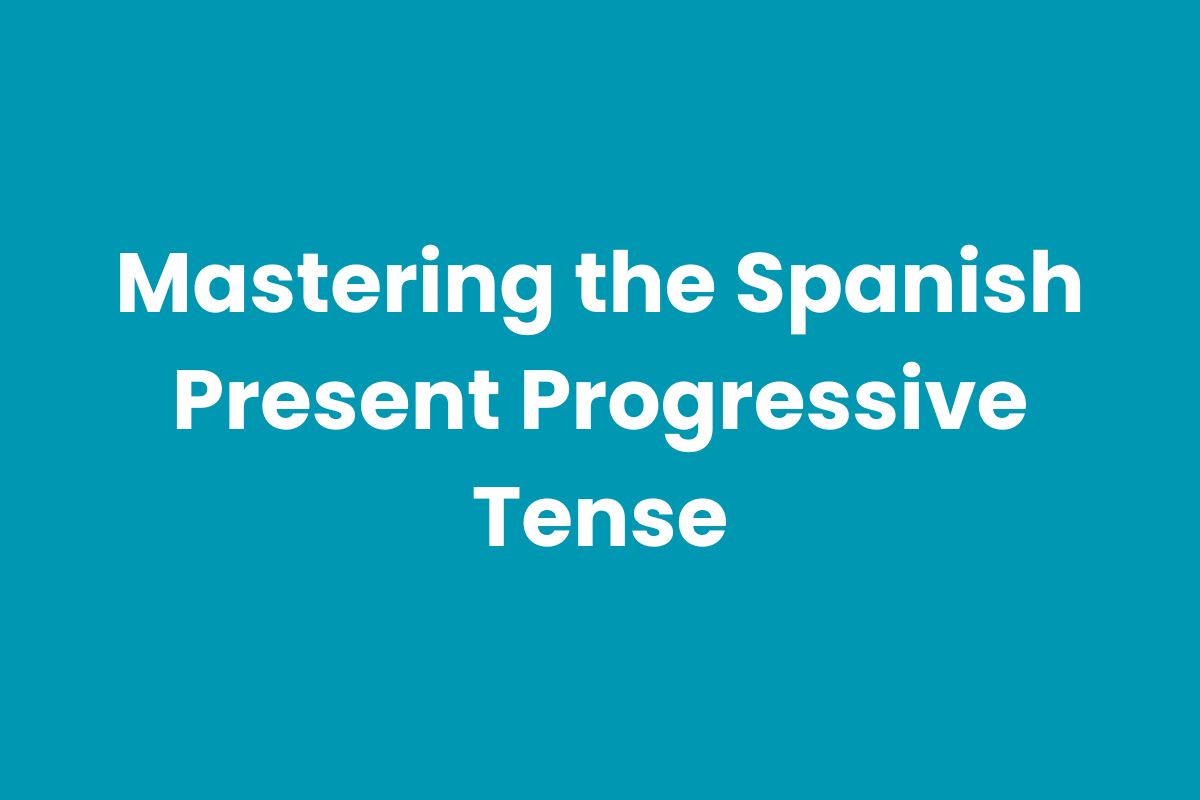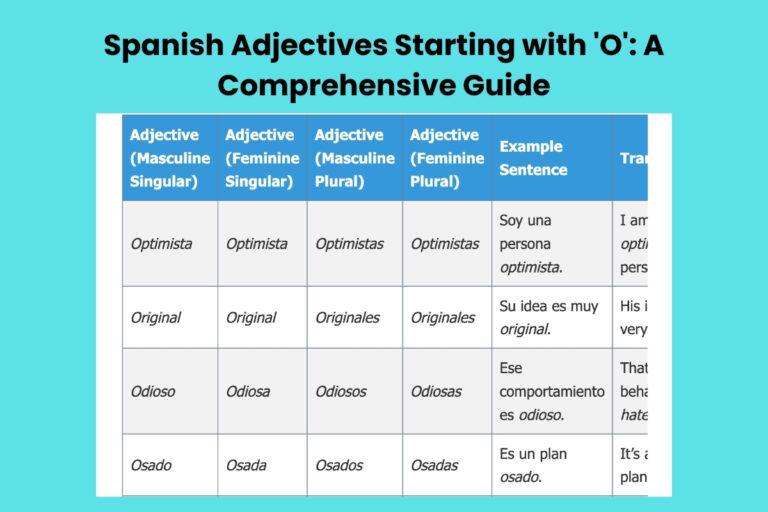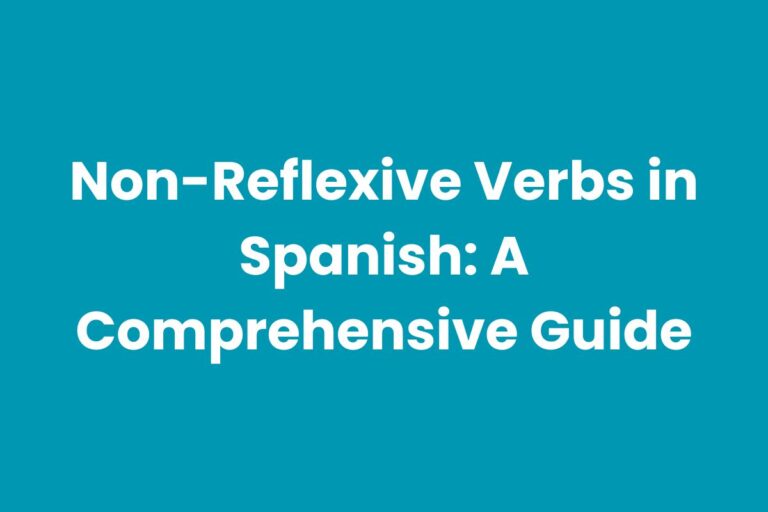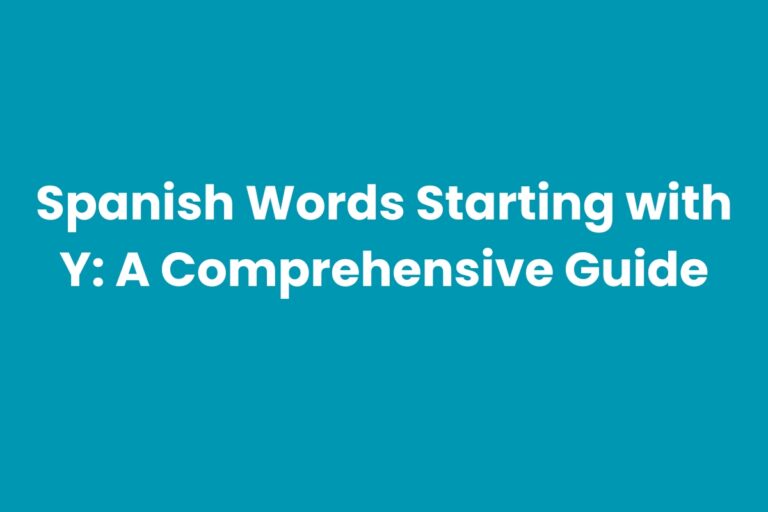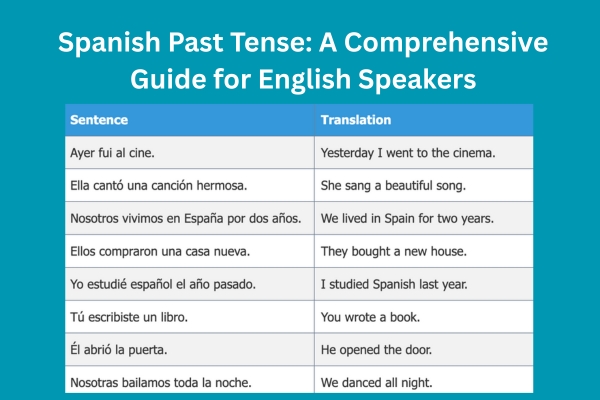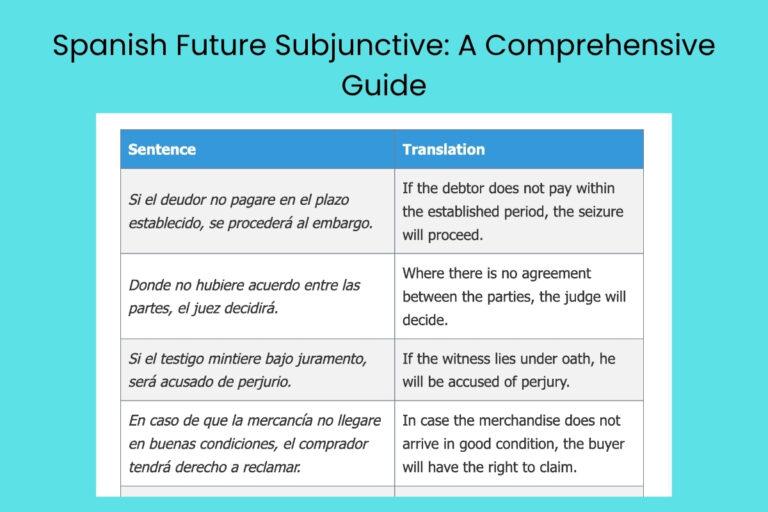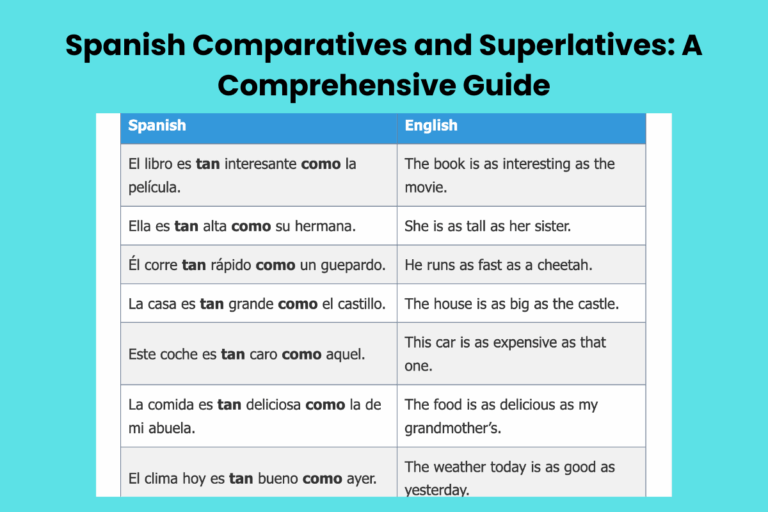Mastering the Spanish Present Progressive Tense
The Spanish present progressive tense, also known as the present continuous tense, is crucial for describing actions happening right now. Understanding this tense allows you to express what someone is doing at this very moment, adding immediacy and vividness to your descriptions.
This article provides a comprehensive guide to the Spanish present progressive, covering its formation, usage, common mistakes, and advanced applications. Whether you’re a beginner or an advanced learner, this guide will help you master this essential aspect of Spanish grammar and improve your fluency.
Table of Contents
- Introduction
- Definition of the Spanish Present Progressive
- Structural Breakdown
- Types and Categories
- Examples of the Present Progressive
- Usage Rules
- Common Mistakes
- Practice Exercises
- Advanced Topics
- FAQ
- Conclusion
Definition of the Spanish Present Progressive
The Spanish present progressive tense, known as the presente progresivo or presente continuo, is used to describe actions that are currently in progress at the moment of speaking. It’s equivalent to the English present continuous tense (e.g., “I am speaking,” “They are eating”). This tense emphasizes the ongoing nature of an action, highlighting that it is happening right now and is not yet completed.
The present progressive is a compound tense, meaning it is formed using an auxiliary verb and a main verb form. In Spanish, the auxiliary verb is always estar (to be), and the main verb is in its gerund form (gerundio). The gerund is a non-finite verb form that ends in -ando for -ar verbs and -iendo for -er and -ir verbs.
The primary function of the present progressive is to express actions happening at the moment of speaking. It can also describe temporary situations, actions repeated over a short period, or, with caution, future plans.
Its usage is generally more restricted than the English present continuous, as Spanish often uses the simple present tense to describe actions happening now.
Structural Breakdown
The structure of the Spanish present progressive tense is straightforward but requires understanding the components of the auxiliary verb estar and the gerund form of the main verb. Let’s break down each element:
The Verb Estar
Estar is an irregular verb meaning “to be.” It is used to indicate temporary states, locations, and, crucially, to form the present progressive tense. The conjugation of estar in the present tense is as follows:
| Pronoun | Conjugation of Estar |
|---|---|
| Yo (I) | Estoy |
| Tú (You, informal) | Estás |
| Él/Ella/Usted (He/She/You, formal) | Está |
| Nosotros/Nosotras (We) | Estamos |
| Vosotros/Vosotras (You, informal plural, Spain) | Estáis |
| Ellos/Ellas/Ustedes (They/You, plural) | Están |
Memorizing the conjugations of estar is essential for correctly forming the present progressive tense. The correct form of estar must match the subject of the sentence.
The Gerund (Gerundio)
The gerund (gerundio) is a non-finite verb form that functions as an adverb, modifying the verb estar. It indicates the manner in which the action is being performed. The gerund is formed differently depending on whether the verb ends in -ar, -er, or -ir.
- -ar verbs: Replace the -ar ending with -ando. Example: hablar (to speak) becomes hablando (speaking).
- -er verbs: Replace the -er ending with -iendo. Example: comer (to eat) becomes comiendo (eating).
- -ir verbs: Replace the -ir ending with -iendo. Example: vivir (to live) becomes viviendo (living).
Here is a table showing the formation of the gerund for regular verbs:
| Infinitive | Gerund | English Translation |
|---|---|---|
| Hablar (to speak) | Hablando | Speaking |
| Comer (to eat) | Comiendo | Eating |
| Vivir (to live) | Viviendo | Living |
| Cantar (to sing) | Cantando | Singing |
| Beber (to drink) | Bebiendo | Drinking |
| Escribir (to write) | Escribiendo | Writing |
| Bailar (to dance) | Bailando | Dancing |
| Leer (to read) | Leyendo | Reading |
| Abrir (to open) | Abriendo | Opening |
| Estudiar (to study) | Estudiando | Studying |
With a solid understanding of both estar conjugations and gerund formation, you can now construct the present progressive tense.
Types and Categories
While the basic structure of the present progressive remains consistent, there are variations depending on the type of verb being used. These variations primarily involve irregular gerund forms.
Regular Verbs
Regular verbs follow the standard rules for gerund formation, as described above. Simply replace the infinitive ending (-ar, -er, or -ir) with the corresponding gerund ending (-ando or -iendo).
Examples:
- Estoy hablando español. (I am speaking Spanish.)
- Ella está comiendo una manzana. (She is eating an apple.)
- Nosotros estamos viviendo en España. (We are living in Spain.)
Irregular Verbs
Some verbs have irregular gerund forms. These irregularities typically involve a change in the stem of the verb.
Common irregular gerunds include:
- Leer (to read) → Leyendo
- Oír (to hear) → Oyendo
- Traer (to bring) → Trayendo
Examples:
- Estoy leyendo un libro. (I am reading a book.)
- Él está oyendo música. (He is hearing music.)
- Estamos trayendo la comida. (We are bringing the food.)
Stem-Changing Verbs
Stem-changing verbs undergo a change in the stem vowel in certain conjugations. Some stem-changing verbs also have a stem change in the gerund. These changes typically occur in -er and -ir verbs.
Common stem changes in the gerund include:
- e → i: Pedir (to ask for) → Pidiendo
- o → u: Dormir (to sleep) → Durmiendo
Examples:
- Estoy pidiendo ayuda. (I am asking for help.)
- Él está durmiendo ahora. (He is sleeping now.)
Here is a table of Stem-changing verbs in the gerund:
| Infinitive | Gerund | Stem Change | English Translation |
|---|---|---|---|
| Pedir (to ask for) | Pidiendo | e → i | Asking for |
| Dormir (to sleep) | Durmiendo | o → u | Sleeping |
| Sentir (to feel) | Sintiendo | e → i | Feeling |
| Servir (to serve) | Sirviendo | e → i | Serving |
| Vestir (to dress) | Vistiendo | e → i | Dressing |
| Morir (to die) | Muriendo | o → u | Dying |
| Mentir (to lie) | Mintiendo | e → i | Lying |
| Preferir (to prefer) | Prefiriendo | e → i | Preferring |
Understanding these variations ensures accurate and fluent use of the present progressive tense.
Examples of the Present Progressive
To solidify your understanding, let’s examine various examples of the present progressive tense in different sentence structures.
Affirmative Sentences
Affirmative sentences state that an action is currently in progress.
Here is a table of examples:
| Spanish Sentence | English Translation |
|---|---|
| Estoy trabajando ahora mismo. | I am working right now. |
| Estás estudiando para el examen. | You are studying for the exam. |
| Ella está cantando una canción. | She is singing a song. |
| Estamos comiendo pizza. | We are eating pizza. |
| Están escribiendo un libro. | They are writing a book. |
| Estoy aprendiendo español. | I am learning Spanish. |
| Estás viviendo en Madrid. | You are living in Madrid. |
| Él está jugando al fútbol. | He is playing soccer. |
| Estamos viendo una película. | We are watching a movie. |
| Están bailando en la fiesta. | They are dancing at the party. |
| Estoy leyendo un periódico. | I am reading a newspaper. |
| Estás bebiendo agua. | You are drinking water. |
| Ella está cocinando la cena. | She is cooking dinner. |
| Estamos escuchando música. | We are listening to music. |
| Están limpiando la casa. | They are cleaning the house. |
| Estoy pensando en ti. | I am thinking about you. |
| Estás conduciendo muy rápido. | You are driving very fast. |
| Él está abriendo la puerta. | He is opening the door. |
| Estamos cerrando la ventana. | We are closing the window. |
| Están subiendo la escalera. | They are climbing the stairs. |
| Estoy bajando del autobús. | I am getting off the bus. |
| Estás nadando en la piscina. | You are swimming in the pool. |
| Ella está corriendo en el parque. | She is running in the park. |
| Estamos caminando por la calle. | We are walking down the street. |
Negative Sentences
Negative sentences indicate that an action is not currently in progress. The word no is placed before the verb estar.
Here is a table of examples:
| Spanish Sentence | English Translation |
|---|---|
| No estoy trabajando ahora. | I am not working now. |
| No estás estudiando. | You are not studying. |
| Ella no está cantando. | She is not singing. |
| No estamos comiendo. | We are not eating. |
| No están escribiendo. | They are not writing. |
| No estoy aprendiendo nada. | I am not learning anything. |
| No estás viviendo aquí. | You are not living here. |
| Él no está jugando. | He is not playing. |
| No estamos viendo la televisión. | We are not watching television. |
| No están bailando ahora. | They are not dancing now. |
| No estoy leyendo ese libro. | I am not reading that book. |
| No estás bebiendo vino. | You are not drinking wine. |
| Ella no está cocinando hoy. | She is not cooking today. |
| No estamos escuchando las noticias. | We are not listening to the news. |
| No están limpiando el coche. | They are not cleaning the car. |
| No estoy pensando en eso. | I am not thinking about that. |
| No estás conduciendo bien. | You are not driving well. |
| Él no está abriendo el regalo. | He is not opening the gift. |
| No estamos cerrando la puerta. | We are not closing the door. |
| No están subiendo al tren. | They are not getting on the train. |
| No estoy bajando la velocidad. | I am not slowing down. |
| No estás nadando rápido. | You are not swimming fast. |
| Ella no está corriendo mucho. | She is not running much. |
| No estamos caminando lejos. | We are not walking far. |
Interrogative Sentences
Interrogative sentences ask whether an action is currently in progress. In Spanish, you can form a question by simply changing the intonation of the sentence, or by adding question marks and inverting the subject and verb.
Here is a table of examples:
| Spanish Sentence | English Translation |
|---|---|
| ¿Estás trabajando? / ¿Estás tú trabajando? | Are you working? |
| ¿Está ella cantando? / ¿Está cantando ella? | Is she singing? |
| ¿Estamos comiendo? / ¿Estamos nosotros comiendo? | Are we eating? |
| ¿Están escribiendo? / ¿Están ellos escribiendo? | Are they writing? |
| ¿Estoy aprendiendo bien? / ¿Estoy yo aprendiendo bien? | Am I learning well? |
| ¿Estás viviendo aquí? / ¿Estás tú viviendo aquí? | Are you living here? |
| ¿Está él jugando? / ¿Está jugando él? | Is he playing? |
| ¿Estamos viendo la tele? / ¿Estamos nosotros viendo la tele? | Are we watching TV? |
| ¿Están bailando juntos? / ¿Están ellos bailando juntos? | Are they dancing together? |
| ¿Estoy leyendo correctamente? / ¿Estoy yo leyendo correctamente? | Am I reading correctly? |
| ¿Estás bebiendo eso? / ¿Estás tú bebiendo eso? | Are you drinking that? |
| ¿Está ella cocinando algo rico? / ¿Está cocinando ella algo rico? | Is she cooking something delicious? |
| ¿Estamos escuchando atentamente? / ¿Estamos nosotros escuchando atentamente? | Are we listening attentively? |
| ¿Están limpiando el portal? / ¿Están ellos limpiando el portal? | Are they cleaning the entrance? |
| ¿Estoy pensando demasiado? / ¿Estoy yo pensando demasiado? | Am I thinking too much? |
| ¿Estás conduciendo con cuidado? / ¿Estás tú conduciendo con cuidado? | Are you driving carefully? |
| ¿Está él abriendo el paquete? / ¿Está abriendo él el paquete? | Is he opening the package? |
| ¿Estamos cerrando el trato? / ¿Estamos nosotros cerrando el trato? | Are we closing the deal? |
| ¿Están subiendo las maletas? / ¿Están ellos subiendo las maletas? | Are they taking up the suitcases? |
| ¿Estoy bajando bien la escalera? / ¿Estoy yo bajando bien la escalera? | Am I going down the stairs correctly? |
| ¿Estás nadando a la orilla? / ¿Estás tú nadando a la orilla? | Are you swimming to the shore? |
| ¿Está ella corriendo muy rápido? / ¿Está corriendo ella muy rápido? | Is she running very fast? |
| ¿Estamos caminando en la dirección correcta? / ¿Estamos nosotros caminando en la dirección correcta? | Are we walking in the right direction? |
Usage Rules
The Spanish present progressive tense has specific usage rules that differ from the English present continuous. Understanding these rules is crucial for avoiding errors.
Actions in Progress
The primary use of the present progressive is to describe actions happening at the moment of speaking. This is the most direct and common usage.
Examples:
- Estoy escribiendo un correo electrónico. (I am writing an email.)
- El perro está ladrando. (The dog is barking.)
- Estamos cenando ahora. (We are having dinner now.)
Temporary Situations
The present progressive can also describe temporary situations or actions that are not habitual.
Examples:
- Estoy viviendo en Barcelona este mes. (I am living in Barcelona this month.)
- Ella está trabajando en un proyecto especial. (She is working on a special project.)
Repeated Actions
The present progressive can indicate actions that are repeated over a short period, especially if they are annoying or surprising.
Examples:
- Siempre estás llegando tarde. (You are always arriving late.)
- Está lloviendo mucho últimamente. (It is raining a lot lately.)
Future Plans (with Caution)
While the simple present tense is generally preferred for future plans in Spanish, the present progressive can be used to emphasize that the plan is already in progress or very certain. Use this sparingly.
Examples:
- Estoy saliendo mañana por la mañana. (I am leaving tomorrow morning.) – Implies preparations are underway.
It’s crucial to remember that Spanish often uses the simple present tense where English would use the present continuous. Overusing the present progressive can sound unnatural.
Common Mistakes
Several common mistakes can occur when using the Spanish present progressive tense. Being aware of these errors can help you avoid them.
- Overusing the present progressive: As mentioned earlier, Spanish often uses the simple present tense for actions happening now.
- Incorrect: Estoy queriendo un café.
- Correct: Quiero un café. (I want a coffee.)
- Incorrect gerund formation: Not applying stem changes or using incorrect endings.
- Incorrect: Estoy pediendo ayuda.
- Correct: Estoy pidiendo ayuda. (I am asking for help.)
- Incorrect conjugation of estar: Using the wrong form of estar.
- Incorrect: Yo estás hablando.
- Correct: Yo estoy hablando. (I am speaking.)
Here is a table showcasing common mistakes and their corrections:
| Incorrect Sentence | Correct Sentence | Explanation |
|---|---|---|
| Estoy queriendo ir al cine. | Quiero ir al cine. | Using simple present for desires. |
| Él está hacendo la tarea. | Él está haciendo la tarea. | Correct gerund form of hacer. |
| Nosotros estámos comiendo. | Nosotros estamos comiendo. | Correct conjugation of estar. |
| Estoy sabiendo la respuesta. | Sé la respuesta. | Using simple present for knowing. |
| Ellos están corrindo en el parque. | Ellos están corriendo en el parque. | Correct gerund form of correr. |
Practice Exercises
Test your understanding of the Spanish present progressive tense with the following exercises. Provide the correct form of the verb in parentheses.
- Yo ________ (escribir) una carta a mi amigo.
- Tú ________ (comer) una manzana.
- Ella ________ (vivir) en Madrid este año.
- Nosotros ________ (estudiar) para el examen.
- Ellos ________ (trabajar) en la oficina.
- ¿ ________ (dormir) tú ahora?
- Él no ________ (escuchar) la radio.
- Nosotros ________ (aprender) español.
- Ellas ________ (bailar) en la fiesta.
- Yo ________ (leer) un libro interesante.
Answer Key:
- estoy escribiendo
- estás comiendo
- está viviendo
- estamos estudiando
- están trabajando
- Estás durmiendo
- está escuchando
- estamos aprendiendo
- están bailando
- estoy leyendo
Exercise 2: Rewrite the following sentences using the present progressive tense.
- Yo como pizza. (I eat pizza.)
- Ella escribe un libro. (She writes a book.)
- Nosotros vivimos en España. (We live in Spain.)
- Él estudia mucho. (He studies a lot.)
- Ellos trabajan aquí. (They work here.)
- Tu cantas muy bien. (You sing very well).
- Yo leo el periodico. (I read the newspaper).
- Ella bebe agua. (She drinks water).
- Nosotros cocinamos la cena. (We cook dinner).
- Ellos limpian la casa. (They clean the house).
Answer Key:
- Estoy comiendo pizza.
- Ella está escribiendo un libro.
- Nosotros estamos viviendo en España.
- Él está estudiando mucho.
- Ellos están trabajando aquí.
- Estás cantando muy bien.
- Estoy leyendo el periodico.
- Ella está bebiendo agua.
- Nosotros estamos cocinando la cena.
- Ellos están limpiando la casa.
Advanced Topics
For advanced learners, mastering the nuances of the present progressive with reflexive verbs and pronoun placement is essential.
Reflexive Verbs in the Present Progressive
Reflexive verbs describe actions that the subject performs on themselves. When using reflexive verbs in the present progressive, the reflexive pronoun can be placed before estar or attached to the gerund.
Examples:
- Me estoy lavando las manos. OR Estoy lavándome las manos. (I am washing my hands.)
- Se está vistiendo. OR Está vistiéndose. (He is getting dressed.)
Pronoun Placement
When attaching the reflexive pronoun to the gerund, an accent mark is often required to maintain the correct stress. The accent is placed on the vowel that would normally be stressed in the gerund.
Examples:
- Lavando → Lavándome
- Vistiendo → Vistiéndose
Correct pronoun placement and accentuation are crucial for clear and accurate communication.
FAQ
- What is the difference between ser and estar?
Ser is used for permanent characteristics, origin, and identity, while estar is used for temporary states, locations, and the present progressive tense. Ser describes *what* something is, while *estar* describes *how* or *where* something is.
- When should I use the simple present tense instead of the present progressive?
Use the simple present tense for habitual actions, facts, and general truths. Use the present progressive for actions happening at the moment of speaking or temporary situations.
- Can I use the present progressive for future plans?
Yes, but sparingly. It’s generally better to use the simple present tense or the future tense for future plans. The present progressive emphasizes that the plan is already in progress or very certain.
- How do I form the gerund of irregular verbs?
Some verbs have irregular gerund forms. Consult a verb conjugation table or dictionary to find the correct form. Common irregularities include stem changes (e.g., pedir → pidiendo) and completely irregular forms (e.g., leer → leyendo).
- Where do I place pronouns in the present progressive?
Pronouns can be placed before estar or attached to the gerund. When attaching to the gerund, an accent mark may be required.
- Is the Spanish present progressive used as frequently as the English present continuous?
No, the Spanish present progressive is used less frequently than the English present continuous. Spanish often uses the simple present tense where English would use the present continuous.
- How do I know when a stem-changing verb changes in the gerund?
Generally, -ir verbs that have a stem change in the present tense (e -> i or o -> u) will also have that stem change in the gerund. Consult a verb conjugation resource to confirm.
- What happens with reflexive pronouns when using the present progressive?
Reflexive pronouns can either precede the verb *estar* or be attached to the gerund, requiring an accent mark on the gerund to maintain proper pronunciation.
- Can the present progressive be used with adverbs of frequency?
Yes, especially to express annoyance or surprise about a repeated action. For example: “Siempre estás llegando tarde” (You are always arriving late).
- How do I form questions using the present progressive
You can form questions in Spanish by simply changing your intonation or by inverting the subject and verb. For example: “¿Estás comiendo?” (Are you eating?) or “¿Está comiendo él?” (Is he eating?).
Conclusion
Mastering the Spanish present progressive tense is essential for expressing actions happening in the moment and adding depth to your Spanish communication. By understanding its structure, usage rules, and common exceptions, you can confidently describe ongoing activities and temporary situations.
Remember to practice regularly and be mindful of the nuances that differentiate it from the English present continuous. With consistent effort, you’ll be well on your way to fluent and accurate use of the Spanish present progressive tense.

